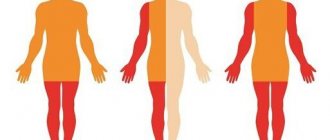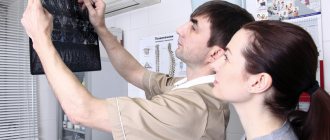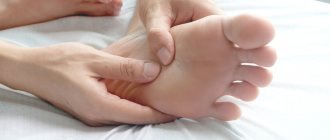Venous diseases often appear due to upright walking. A person must lead an active lifestyle, play sports, and not overload the body with heavy food in order to ensure uninterrupted movement of blood through the veins to the heart. But the outflow of blood can be impaired, due to various reasons. As a result, vein diseases appear.
Forms of venous insufficiency
Venous insufficiency is a chronic disease of the veins. It manifests itself as swelling, pain, cramps, and the appearance of subcutaneous tissue. In more advanced stages, ulcers may form.
The condition of the veins is influenced by the following factors:
- hereditary predisposition;
- hormonal imbalance, pregnancy, use of hormonal drugs;
- excess weight;
- passive lifestyle;
- static loads.
There are two forms of venous disease:
- Acute venous insufficiency (AVI). Appears as a result of a sharp disruption of blood flow in the deep veins of the legs. It may occur subsequently with the development of other diseases or drug intoxication. The patient experiences pain, swelling, the skin on the legs becomes blue, and the veins are clearly visible.
- Chronic disease (CVI). Appears gradually. At first it may be asymptomatic, but over time swelling and pain appear. The chronic form can occur as a result of varicose veins, which the patient ignored.
Why is venous congestion in the legs dangerous?
1. The risk of developing superficial thrombophlebitis Venous congestion in the legs is accompanied by an increase in blood viscosity. Increased blood clotting and a decrease in the speed of venous blood flow provoke the formation of blood clots (thrombi) on the inner surface of the vascular walls of the veins. Having come off the vein wall and entering the venous bed, the thrombus can clog a superficial vein of small diameter and provoke superficial thrombophlebitis. Blockage of a vein leads to disruption of the blood supply to the skin area. Over time, a difficult-to-treat trophic ulcer forms on the affected area of the skin.
2. Risk of developing varicose veins Stagnation of blood in the legs increases the pressure inside the veins. Under the influence of excess pressure, the veins begin to stretch and appear under the skin, forming a network of dilated veins in the legs. Increased pressure inside the veins “squeezes” the liquid part of the blood through the vascular walls of the veins into the muscles and subcutaneous tissue of the legs. Because of this, severe varicose edema occurs.
The Russian company produces compression garments intended for the treatment of venous stagnation , varicose veins, lymphatic and post-traumatic edema. You can learn more about how Intex elastic stockings and tights help with varicose veins in the article “Treatment of Venous Congestion.”
Reasons for appearance
The most important factor in the occurrence of vein diseases is hereditary predisposition. It is this that determines the characteristics of the condition of tissues and blood vessels.
Another reason is associated with diseases and conditions caused by problems with venous circulation: thrombosis, trauma, varicose veins.
The third group of factors includes lifestyle: passive lifestyle, excess weight, excessive loads that involve lifting heavy objects. No less significant factors are the age category and hormonal background of the patient.
Doctors consider the following people at risk:
- athletes;
- women (pregnancy and changes in hormonal levels can affect venous circulation);
- people who have a family history of venous disease.
Symptoms of impaired venous outflow from the brain
A diagnosis with this name does not exist in reference books, but it is meant when they talk about chronic venous insufficiency and other lesions of the veins.
This is a condition in which the venous network cannot satisfactorily fulfill its task of draining blood saturated with carbon dioxide and toxins from the organ.
For the brain, this situation is especially detrimental, since it is not diagnosed for a long time, and in the final stages it can lead to disability.
What should you pay attention to so as not to miss an outflow defect?
Symptoms are noted depending on the stage of the disorder:
- Initial. The signs are easy to mistake for ordinary fatigue and stress; they are expressed in periodic headaches, insomnia, and nausea. Memory and mood deteriorate (this happens to everyone).
- Second stage. There is a transformation of the personality in the form of hot temper, apathy, depressive notes, the symptoms of the first stage progress (it’s just fatigue, a lot of things have accumulated);
- Extreme degree. Here the patient expects irreversible disorders of the nervous system, damage to the lobes of the brain responsible for self-awareness and interaction with the outside world. In severe cases, dementia, internal pathology, and loss of control over movements cannot be ruled out. Venous encephalopathy develops, or a syndrome of deep neurological problems that can no longer be ignored.
The body manages to remain in the latent stage for quite a long time due to the high adaptive properties of the brain. If the throughput of one of the veins is interrupted, other elements of the venous blood flow come to the rescue, because venous blood must leave the head cavity in any way. The load on neighboring venous beds increases, they are forced to expand and gradually lose their elasticity and atrophy.
Venous sinuses are additional pathways for the outflow of blood; they are created by dense membranes, do not contain valves or muscle fibers, which allows fluid to flow freely into them.
When the compensatory capabilities of the venous network of the brain are exhausted, without adequate treatment, a sharp deterioration in well-being will begin.
Diagnosis and treatment
Chronic venous insufficiency may be accompanied by cramps, swelling of the lower extremities, and pain. But in some cases, the disease can pass without pronounced symptoms. To identify pathology, it is worth undergoing an examination. This will require a general and biochemical blood test, ultrasound of the legs, and phlebography.
The results of the examination will allow you to determine an accurate diagnosis and prescribe the correct treatment, including medicinal and non-medicinal agents. In many cases, compression treatment is prescribed, which will stabilize the movement of blood through the veins. You should also adhere to a certain diet and lead an active lifestyle. If you are obese, then you should reduce your body weight. Medication measures include taking venotonic drugs.
Cerebral circulation
The brain accounts for only 2% of the mass of the entire body, and it consumes from 10% of energy even at rest - and up to 25% during periods of powerful intellectual activity. The outflow of metabolic products is no less important than nutrition. But if impaired blood supply is associated with obvious and often fatal dysfunctions, then venous congestion does not make itself felt for a long time and manifests itself in the form of protracted illnesses that greatly worsen the quality of life. If pathology is ignored for a long time, the consequences become irreparable.
Osteopathy considers any symptoms as a sign that something is wrong with the body; diagnosis and correction are needed. Especially when it comes to migraines, drowsiness, and feelings of powerlessness.
Osteopathic doctors have perfect knowledge of the anatomy and functionality of the blood vessels of the brain, thanks to which they determine the location of the “breakdown”. Every detail matters.
There are deep and superficial veins of the brain and venous sinuses of the dura mater. The first pass through the thickness of the white matter and collect processed blood directly from it, as well as the hemispheric nuclei, thalamus, and choroid plexus of the brain.
Venous vessels located on the surface are responsible for draining blood from the cerebral cortex and cerebellum.
The sinuses, paired and unpaired, are formed by splitting the brain membrane and represent some kind of reservoirs into which waste blood enters before exiting into the external venous drainage of the skull.
Since the sinuses are containers with dense walls that are almost not subject to deformation, they seem to protect flexible elastic vessels in the process of blood outflow. Communication with the superficial venous network is carried out through the emissary and diploic nerves.
The outflow from the head and neck is realized through the internal and external jugular venous ducts, which flow into the brachiocephalic ducts and then into the superior vena cava, and it directly communicates with the right atrium.
The blood outflow mechanism, which operates autonomously, is very vulnerable. Violation of venous outflow is provoked by various factors and subsequently causes serious illnesses.
In addition, due to venous stagnation, blood enriched with oxygen and biologically active elements does not flow in sufficient volume.
Treatment of cerebral venous outflow dysfunction
Allopathic medicine traditionally treats diseases. Venotonics and other vascular drugs are widely used in the treatment of venous pathology.
Yes, they can improve the quality of the venous flow and general well-being, but without systemic regular treatment, the problem of venous outflow of the brain will again make itself felt.
To get rid of discomfort, brain activity drugs, diuretics, and anticoagulants are also used. The home first aid kit and knowledge in the field of pharmaceuticals are replenished, but this does not make you feel healthier, except for periods.
Treatment with osteopathic techniques is aimed at long-term effects. This is achieved by soft and gradual removal of compensation and the revival of natural functions. It is important not only to establish venous outflow, but also to eliminate the root causes of the disorder.
Next, work is carried out on the changes caused by venous insufficiency.
At the first appointment, the osteopath removes the disorders visible to him:
- Muscle tone that compresses and squeezes the veins of the head and cervical area;
- Displacements of the cranial and bones;
- Deformations in the spinal column.
Since the basis for impaired venous outflow is often osteochondrosis, the osteopath interacts with the spine along its entire length, paying attention to the pelvic area.
How is the pelvis connected to the venous system of the head? Directly. Osteoscience perceives the body as a single structure in which there is nothing separate. Even an old injury to the coccyx can, over a period of time, cause a disruption in the functioning of the cerebral vessels, affecting the spine, which in turn puts pressure on the cranial vault and causes tension in the muscles and veins of the neck.
There is another connection. Since cerebrospinal fluid continuously circulates in the spinal canal, it is necessary that its rhythm correspond to the micromovements of the cranial plates. In osteopathy, their mobility is usually compared to breathing, the disruption of which provokes multiple diseases. Treatment includes restoring bone mobility in the head.
During treatment, the osteopath may stand motionless for several seconds or minutes with his eyes closed, placing his hands on one part of the body, then on another. From the outside it seems that nothing is happening, and the patient does not feel any pain or pressure. This is how doctors find flaws and initiate self-regulation.
Most of our clients noted positive changes after starting treatment - ease of breathing, a feeling of vigor after sleep, improved memory and motivation.
But in some cases, so-called side effects occur. They are short-term and are explained by the body ridding itself of acquired compensations. He strives to preserve himself and, in response to damage, includes all kinds of protection to the detriment of full functionality. The structures of vital activity adapt to function in less than healthy conditions, and after eliminating the problem, it is difficult for them to return to their original state. The osteopath’s task is to do this as gently as possible.
Any alarming symptoms that arise should be discussed with your doctor. If it is moderate pain, insomnia or too much sleep, weakness, nausea - most likely everything is within normal limits.
These symptoms will quickly pass, but the treatment cannot be considered complete, since one session (regardless of how you feel after it) is not enough to work through all the problems. Subsequent visits to the clinic are necessary to assess the intermediate result and determine further tactics.
Why is venous outflow disrupted?
The reasons may lie both in the vascular pathology itself and in other abnormalities, including:
- Tumors in the neck and head of various etiologies;
- Heart disorder;
- Diseases of an infectious nature, including meningitis;
- Osteochondrosis;
- Respiratory tract impairment, accompanied by suffocation and coughing.
Blockage of veins is also caused by residual effects after strokes, bruises - hematomas in the brain. There are cases of congenital narrowing of blood vessels or acquired at birth.
And, unfortunately, almost everyone is faced with factors that systematically worsen the outflow of blood from the brain:
- Stress and muscle tension as its consequence;
- Sedentary time, stooping;
- Clothing that restricts movement;
- Exhausting physical labor, sport at the limit of strength;
- Alcohol, overeating and other bad habits;
- Uncontrolled use of vasoconstrictor drugs.
Indirectly, insufficient blood flow can also be blamed on such phenomena as frequent constipation and difficult childbirth in women, when you have to strain your whole body, after which it is difficult to relax, the tension becomes chronic.
Thrombosis is a vascular condition that is the direct cause of impaired outflow from the brain. It is expressed in partial or complete blockage of the bed by blood clots and can lead in rare cases to coma or death. With venous and sinus thrombosis, the risk of a tragic outcome is much lower than with arterial thrombosis, but the symptoms are unpleasant:
- Prolonged increase in body temperature to the level of subfebrile marks (up to 37.5);
- Headache, cramps, vomiting;
- Visual disturbances, tinnitus;
- Swelling and numbness in the face, neck, and head.
These phenomena are especially striking upon awakening, since in a horizontal position the venous outflow of blood is more difficult, and intracranial pressure increases. Therefore, sleep, regardless of the duration, brings weakness and despondency instead of rest.
The most terrible consequence of venous thrombosis is hemorrhagic stroke. But, fortunately, the pathology does not appear suddenly and it is possible to prevent fatal developments.








